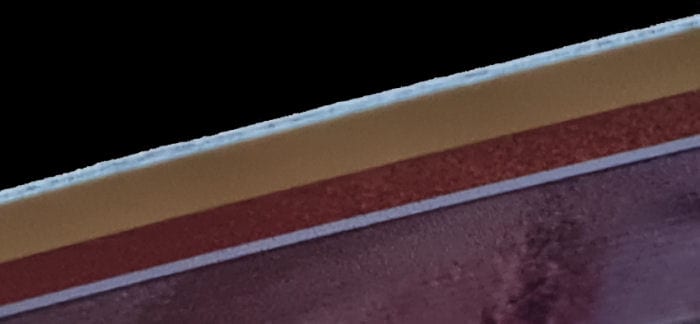Pokémon products are popular throughout the World. Pokémon Trading Card Game (TCG) products are popular with players and collectors alike. Auction sites such as Ebay are flooded with cards and buyers looking for a good deal, but distinguishing between genuine and fake Pokémon cards can be challenging.
This article has been produced to offer some guidance in weeding out fake Pokémon cards. Being aware of what to look for is very useful when considering a purchase.
What are Fake Pokémon Cards?
With such a high level of interest in the Pokémon TCG it is no surprise that forgers want a slice of the pie. While some fake Pokémon cards are immediately obvious, other forgers produce copies that need very close observation to determine whether they are genuine or fake. Indeed, many serious high-value collectors hire Pokémon advisors to check cards for them.
Look and Feel of the Card

If you are able to handle cards prior to purchase this offers a good chance to see if they feel like real cards.
Pokémon cards are made out of card stock and feel like regular playing cards. It is possible to take a bundle of cards and shuffle and deal them out. It is often not possible to do this with fake cards as they may stick to each other.
Genuine Pokémon Cards are not waterproof. A card that is plastic-coated or obviously waterproof is not a real Pokémon card.
Back of the Card
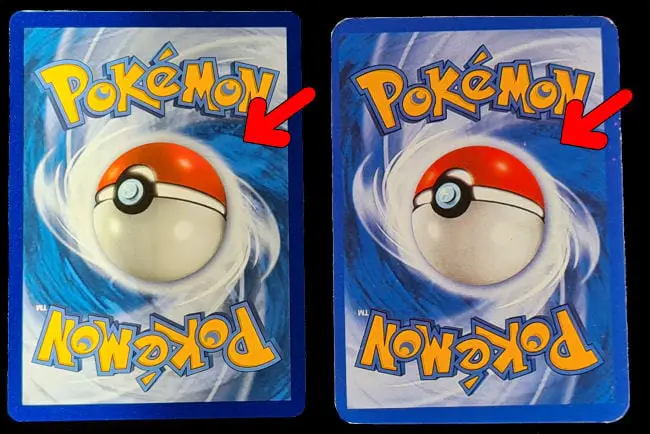
Examining the back of a card is a good way to spot a fake Pokémon card.
In the image the card on the left is a genuine card while the card on the right is counterfeit.
A high percentage of fake cards have the area indicated filled with a single colour while a genuine card has darker splashes of colour within the area.
When purchasing cards online always check to see if the seller has included an image of the back of the card. Genuine sellers will usually happily oblige.
Price of Fake Pokémon Cards
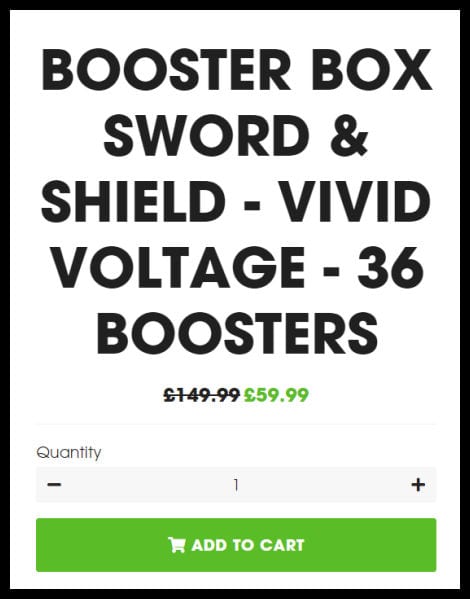
When purchasing sealed products price can be a good indicator that you are buying a genuine product.
Prices for current expansion set products are generally:
Booster packs – £4 – £5 ($5 – $7)
Booster boxes – £95 – £140 ($130 – $200)
Collection boxes – around £20 ($28)
Collection tins – around £20 ($28)
Elite trainer boxes – £40 – £50 ($55 – $70)
Products from earlier sets tend to be more expensive unless they are reprints.
It would be advisable to be wary of any store selling products at vastly reduced prices. The image shown is a screen shot from a newly established online store.
If the price seems too good to be true then it probably is.
Font, Text and Spelling

Pokémon has its own unique font which is not in the public domain.
Producers of counterfeit cards use fonts that are similar and appear genuine. Even when compared with a genuine card the difference in font is not always obvious.
The card on the right is genuine and the only major difference in font is the style of the letter g. The spacing between the letters is also slightly wider on the fake card but that is only noticeable when compared with a genuine card.
Fake Pokémon cards often contain spelling mistakes and may use a plain e rather than an é in the word Pokémon. In the example above, an r has been used instead of an e at the end of Zygarde. However, it should be remembered that genuine cards do sometimes contain mistakes so other factors should be looked at as well.
Colours and Textures
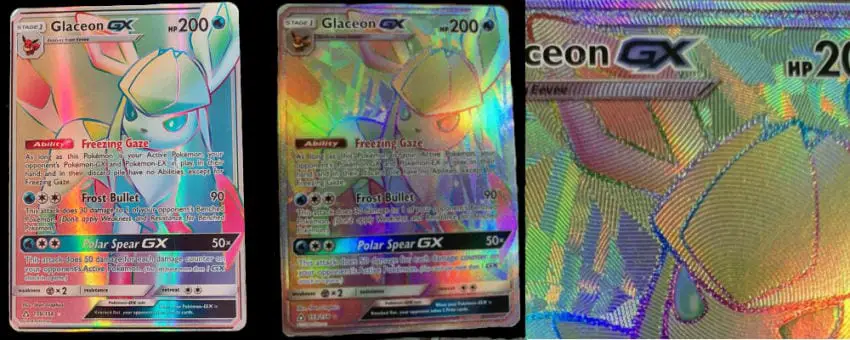
Fake Pokémon cards are often a slightly different colour to the genuine card. The Glaceon GX card on the far left is noticeably different in colour when compared with the genuine card to the right. When looking to purchase a specific card it is important to be aware of the exact colour of that card.
Also important is to be aware of whether the card is textured or smooth. The pseudo card on the left is smooth and has no texture while the genuine card has a textured pattern to the design. This is clearly obvious in the close up image to the far right.
Patterns and Shine lines
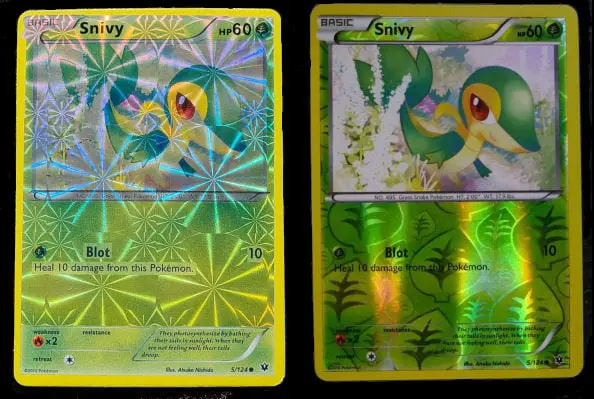
Reverse holo cards have a pattern design that is unique to each expansion series.
The Snivy card shown is from the XY Series. Snivy is a grass Pokémon and all XY series grass type reverse holo cards feature a leaf pattern.
The leaf pattern only extends over the holo part of the card, the image of the Pokémon is not shiny.
The fake card on the left features a circular sun burst pattern and extends over the entire card.
Fake holographic art cards can be detected by the shine lines on the card. Genuine Pokémon cards tend to have diagonal shine lines while those of fake cards are vertical. This is particularly the case for cards from later sets.

Thin Silver Line
Pokémon cards are well made using good card stock. Cards with any holofoil part have three layers. The two outer layers are of card while the inner layer is of silver foil. When the edge of a genuine Pokémon card is viewed through a magnifying glass this silver inner layer can be seen as a thin silver line. The image shows the edge of a card magnified x 25 and the silver line can be clearly seen.
